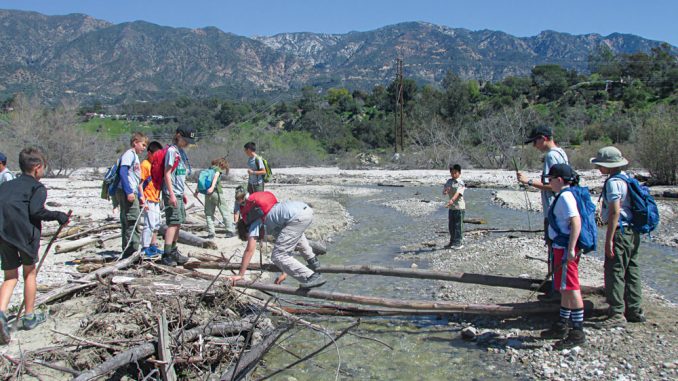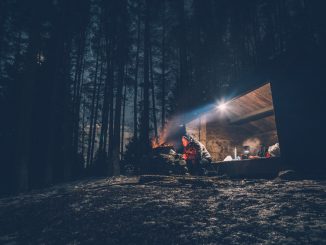
How To Find Water In Austere Environments
A water still is a way to extract water from the soil. The principle is similar to that of a still a moonshiner would make in the woods, but it’s much simpler.
The simplest water still is powered by the sun and nature’s water cycle. However, before we get started, keep in mind that this still, known as a “solar still,” is a method of last resort. Although I’ve made many to learn how to do it and see how it works, I’ve never had to make one in a situation for which it would be life or death to have water.
This is a survival technology that might enable you to get some water when none is apparently available. It’s possible that you’d need to know how to do this if you were lost in the desert or if you were marooned on some remote beach with only sea water. It can also be useful in other environments.

Fresh water streams flow into the ocean. Look for these if you need drinkable water.
First, let’s look at how to make the still. Then, after you see how to make it and how it works, we’re going to explore other ways you might obtain water that are a lot easier and perhaps more reliable than the solar still.
Solar Still
Supplies Required
- One large, clear plastic sheet (ideally at least 6×6 feet)
- A cup or container
- A shovel
It only takes about 30 minutes to dig and set up a solar still, and it can be left there indefinitely.
Location is very important. You should dig in a place where the most water is likely to be found not far below the surface. That means you’re going to dig in a dry stream bed, not up high on a hillside. If you’re at the beach, you’ll dig in the sand above the high-tide line.
In an ideal location, you’re going to dig a hole about 3 feet deep and 3 feet wide. A shovel obviously makes this easier, but I’ve done it with hubcaps and sticks. The type of soil you’re digging in will determine the kind of tool you’ll need.

To make a solar water still, dig a hole about 3 feet deep and 3 feet wide in a spot where water is likely to be underground.

After you’ve dug the hole, pile up the soil around its perimeter.
Place your container in the middle of the hole. You can also place green vegetation (non-toxic) around the container, because the vegetation will also give up some of its water.
Next, cover the hole with the sheet of plastic, and seal the edges of the plastic with the soil you just dug out. Place a stone in the middle of the plastic so that it’s situated directly above the container. It should be just heavy enough to cause the plastic to sag in the middle. That’s it.

A cup is put in the middle of the hole, and vegetation is then placed around the container to add to the still’s output.

The hole is now covered with a sheet of clear plastic, and the edges of the plastic will then be sealed with the soil.

A little stone is placed in the middle of the plastic to form a cone, which points directly into the cup below.

The stone is adjusted so that the cone is properly lined up with the cup.

This diagram shows the cross-section of a solar still. Note that you can insert a tube to suck the water out of the cup. In addition, you can also add a way to pour urine into the still, which also distills down to potable water.
Now, you wait.
If conditions are just right (they rarely are), and if there’s water underground, water will continue to evaporate out of the soil, as it always does as part of the hydrological cycle. Your plastic sheet will trap the moisture that comes out of the hole. It will condense on the underside of the plastic and drip back down into the container. Again, that’s if everything goes right (check out the accompanying pictures, because this is a pretty simple procedure).
How much water can you obtain in your container? In several situations in desert conditions, I had mixed results. After about 24 hours, I have gotten no water (in some cases), a couple of tablespoons and, in a few cases, nearly a quart. The amount you get is highly variable, but it depends largely on the season and the amount of water that’s underground where you dug.
On one occasion when I built a solar still in the mountains, there was heavy dew that night. Nearly a quart of water collected on top of the plastic sheet, but only a few tablespoons had been collected in the inside container.
If you’re stuck on an ocean beach, you already know there’s water underground. When you create a solar still on the beach, you’re basically distilling ocean water, and the water you collect is palatable.
Stranded on a Boat
A growing number of anthropologists believe that the oceans in the past were not barriers to human travel but were the actual “highways” on which people traveled great distances. The trade winds—well-charted prevailing easterly winds near the equator—can take a sailboat from the Mediterranean Sea to the Caribbean Sea, just as they did for Columbus more than 500 years ago.
The path of the trade winds is not devoid of food, as you might think. Along the route, you’ll find ocean birds, lots of fish, turtles and seaweed—all the things that can sustain life on long voyages.
However, what happens when your water supply on the ship runs out? Today, the well-equipped sailor can phone or radio for help. But what if you’re out to sea unexpectedly—without adequate water. What can you do?
In the reports I’ve collected about sailors who survived when their ship floated out in the ocean for 30 days or more, I’ve noted that the survivors all had a few things in common: They all tried to collect rain and dew that collected on the sails or in the boat and used that for their water supply.
One solution to a diminishing source of fresh water is to mix your fresh water with ocean water. Thor Heyerdahl discovered that his crew was able to mix up to 40 percent ocean water with 60 percent fresh water to extend their water supply. They experienced no ill effects and noted that this blend quenched their thirst better than all fresh water.
Other survivors have reported that they would drink ocean water, but only in small sips, little by little. Salty ocean water is not inherently poisonous, as is commonly believed. It contains sodium chloride, potassium chloride and perhaps 20 more suspended minerals. However, if you were to drink it as you would regular water, the result is usually vomiting, diarrhea and a net water loss—which, over time, will lead to dehydration and death. But slow sipping—never really enough at one time to quench the thirst—can be done if you discipline yourself. In addition, it will fight off dehydration until fresh water, such as rain, can be collected. Even so, it’s really not recommended unless you’re very desperate.
Of course, regular intake of fresh water is important. But if your canteens and jugs are totally empty, what can you do? If you planned ahead, you could set out your distillation device, fill it with ocean water and suck out some potable water in a few hours.
“The simplest water still is powered bay the sun and nature’s water cycle.”
A simple still can be made with two buckets and a sheet of plastic. It’s not perfect, and it’s not highly efficient or all that quick, but it’ll distill drinkable water. Here’s how to do it.

A still can be made in the backyard with these parts: a can, bucket, sheet of plastic and some cord.
The simplest version requires two buckets and a sheet of plastic. Place a small bucket into a larger bucket and pour ocean water into the larger one, making sure to avoid getting any in the smaller bucket. You might have to put a rock or a weight in the inner bucket so it stays put. Then, you cover the top with a sheet of clear plastic, securing it with some cordage. Finally, put a weight or stone in the middle of the plastic to create a low spot in the middle that’s over the smaller bucket.

Put the can into the middle of the bucket.

Add rocks to the can so that it won’t float in the water. Alternatively, find a way to secure the can to the bottom of the bucket. Then, add impure water to the bucket, around the can.

Cover the bucket with the sheet of clear plastic and put a stone on the top to create a cone that points into the can.

Condensation on the bottom of the plastic. Note: For various reasons, this isn’t an efficient or quick method. There are many possible ways to distill water, using the sun, fuel and other methods.
As the ocean water evaporates, pure water condenses on the underside of the plastic and drips into the inner bucket. If you’re in a boat that’s constantly moving and rocking, you might not capture a lot of pure water in your inner bucket. Still, it’s worth trying if you have the supplies.
If you expect to be around seawater, bring a water filter that works specifically with seawater. This is the best way to be ready if your supply of fresh water is insufficient.
“It only takes about 30 minutes to dig and set up a solar still, and it can be left there indefinitely.”
But, let’s assume you have no such device. What now?
Dew. Another source of water is dew. By stretching and tying out a sheet of plastic, you could capture dew during the night. The sheet of plastic needs to be tied out with a slope that leads into a container. As the dew settles and coalesces into droplets, they drain into the container. Because this is wholly dependent on weather conditions, you might get a little, or you might get a lot. More dew results during those nights when the daytime has been clear.
Rain. It also rains out at sea, so, again, if you stretch out a sheet of plastic and slope it so it drains into a bucket, you can capture rain water. In the field, I’ve collected a gallon in fewer than 15 minutes during a downpour. How much you can actually collect is determined by how hard it’s raining, as well as the size of your collection “device” (that is, the size of your sheet of plastic and bucket).
Seaweed. Some, but not all, seaweeds, have flotation bubbles that are usually located at the base of the ”leaf.” These can be cut open. The liquid inside is typically less saline than the ocean water. While there isn’t a lot of water in each of these floats—maybe a half-teaspoon per float—it can add up.
Urine. No, no, no! Urine is your body’s waste product. You could use urine to cool down, but why do that when the ocean is all around? Urine is useful for treating chapped skin—but don’t drink it!
Stranded on the Shore
Let’s say you’ve beached up on some unknown shore. There are no towns or villages around where you can get water or help.
So, where do you get your water?
Coconuts. Are you in the South Pacific? Are there coconuts growing on your beach? If so, you can remove the outer husk from a coconut and, using an awl-like device, cut into one of the three “eyes.” If your timing is right, you’ll have some sweet and nourishing water. If not, the coconut could be dry, or the water could be sour.

This man was digging a “body hollow” (a type of primitive shelter) when he hit water! He then built a different shelter nearby, and his “well” provided water.
Digging for water. One way to obtain water from beach areas is to simply dig a well above the high-tide line. The beach will likely be very sandy, so it’ll be hard to dig a deep hole—because the sand continually falls back into the hole. Even so, keep at it. Dig a few inches deeper than the water level. Wait awhile for the water that collects to clarify. This water is significantly less saline than the ocean water, and you might also be able to filter it a bit by running it through a bandanna or other primitive filtration medium.
Streams. Don’t forget that streams and other waterways flow into the ocean. Explore a bit and look for springs and streams; their water might not even have to be distilled.
Just because you found a stream that flows into the ocean doesn’t mean you can drink it without reservation. The simplest method for purifying water of biological contaminants is boiling, which necessitates having the ability to make a fire and some sort of container; for example, a discarded metal can will work fine.
“Don’t panic. Stay calm, and don’t be afraid to adapt, or experiment with, the methods discussed here in your efforts to find a solution.”
Trees. Whether you’re on a beach, in the desert or the mountains, there are often trees around. If you have a clear plastic bag, you can set up a transpiration bag and hope to get some water.

A transpiration bag is simply a clear plastic bag placed over a leafy branch; in this case, a willow branch. The plastic bag captures the transpiring moisture from the tree’s leaves.
It’s really easy: Find a tree with green leaves that are non-toxic. That’s not too hard to do, because the moisture evaporating out of most trees won’t be toxic. Only a few are really bad (oleander is one). Eucalyptus isn’t bad for you, but it doesn’t taste great. On the other hand, trees found along water are the best for a transpiration bag—for instance, willow, alder, cottonwood and even oaks.

A School of Self-Reliance student looks at the willow water that was collected in a transpiration bag. The author had attached the bag 24 hours prior.
Find the south-facing side of the tree (where the sun shines) and gather the leaves from a large branch into a clear plastic bag. Be careful not to puncture the bag. Tie off the bag at the opening and return in a few hours or the next day. You might not get a lot of water with this method, but it only takes about five minutes to set it up, and it’s easy to quickly set up multiple bags.

The author’s students discovered that their transpiration bag had collected almost a quart of willow water. Its palatability and smell would improve if they ran it through a filter before drinking it.
As the tree’s leaves transpire moisture, the water collects in the bag. If conditions are optimal, you’ll get a quart or so in a day. (In case you’re wondering: Yes, the water will taste like the tree it came from.) Move the plastic bag around every other day or so, because the heat inside the bag “cooks” the leaves, and they no longer function well.
Experiment
The methods described here cover the possibilities you could have in most situations, but there might also be other options. The thing to keep in mind is that water is just about everywhere. This is certainly true at the beach and on the ocean. The key is to find potable water or figure out a way to make it.
Don’t panic. Stay calm, and don’t be afraid to adapt, or experiment with, the methods discussed here in your efforts to find a solution.
Editor’s note: A version of this article first appeared in the October, 2020 print issue of American Survival Guide.





Be the first to comment